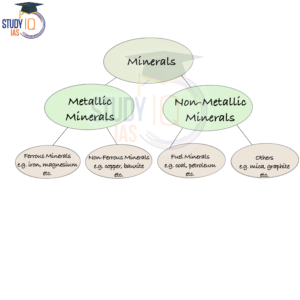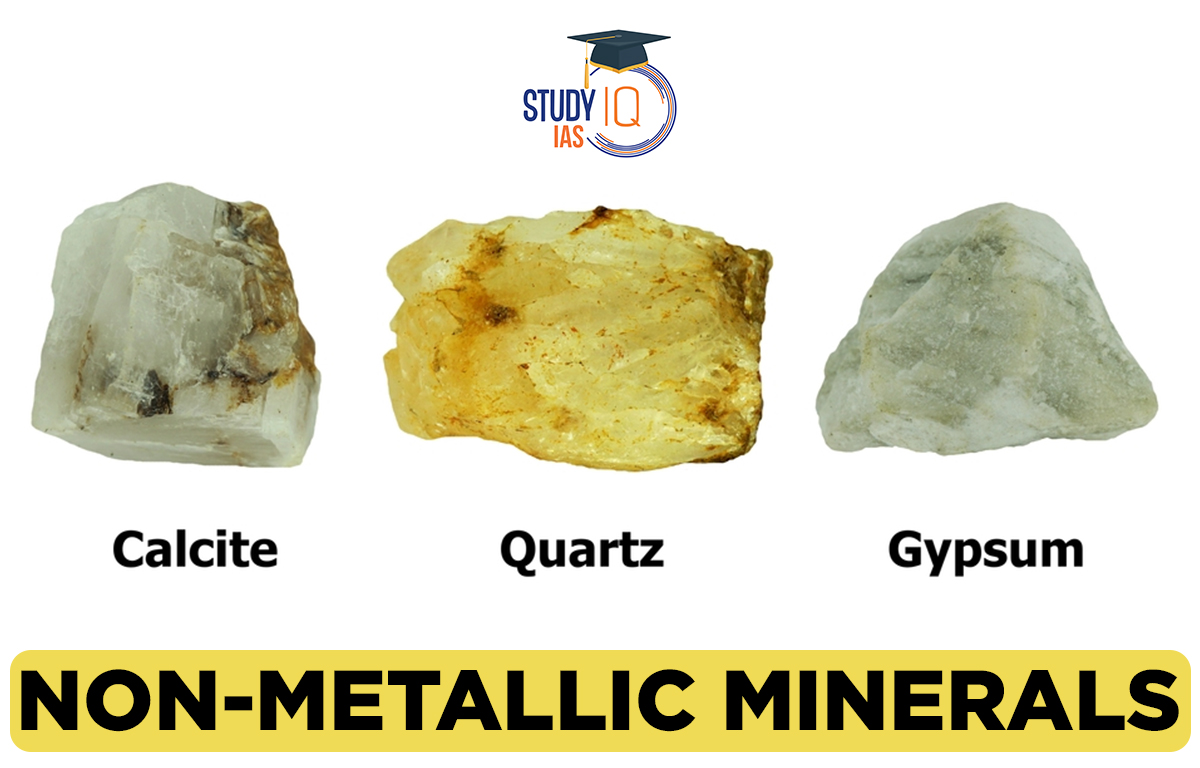Table of Contents
Non-Metallic Minerals
Non-metallic minerals are minerals that do not have any metal elements. Since they lack metals, they are usually found in sedimentary rocks and younger folded mountains.

Read More: Cobalt Ore
Non-Metallic Minerals Examples
Here are some examples of Non Metallic Minerals
- Rocks and Stones: Limestone, granite, marble, sandstone, basalt, etc.
- Industrial Minerals: Clay, kaolin, gypsum, silica sand, talc, feldspar, etc.
- Construction Materials: Cement, sand, gravel, bricks, etc.
- Fuel Minerals: Coal, oil, natural gas, etc.
- Gemstones and Precious Minerals: Diamonds, emeralds, quartz, etc.
Read More: Copper Ore
Mica
- Mica is a non-metallic mineral used in many industries.
- It is a transparent mineral found in igneous rocks.
- Mica crystals can be easily split into very thin, flexible sheets.
- There are two main types of mica: muscovite and biotite.
- Mica is mainly used for electrical insulation in electronic devices.
- It is also used as a filler in cement and asphalt and in building foundations.
- Mica’s shiny, sparkly look makes it popular in toothpaste and cosmetics.
- India produces over 60% of the world’s sheet mica, leading the global mica trade.
- Major mica deposits are found in Rajasthan, Jharkhand, and Bihar.
- The largest mica producers after India are China and Finland.
Read More: Minerals
Uses of Mica
- It is used in wallpapers to provide lustre.
- It is also used in electrical condensers, insulating sheets between commutator segments, and heating components.
Read More: Types of Resources
World Wide Distribution of Mica
China is the largest producer of mica, followed by Finland. India has the largest mica reserves in the world.
| Countries | Regions |
| India | Bihar, Jharkhand, Rajasthan, Andhra Pradesh |
| Brazil | Minas Gerais |
| USA | Northern Carolina, Georgia, New Mexico |
| Russia | Ural, Kola Peninsula, Siberia |
| China | Hebei province |
Read about: Energy Resources
Asbestos
Asbestos is a fibrous silicate mineral found in igneous rocks. There are two main ores of asbestos
- chrysotile
- actinolite.
Asbestos is fireproof, heat resistant, and has low electrical conductivity.
Read More: Types of Rocks
Uses of Asbestos
Asbestos is a naturally occurring mineral that was widely used in various industries due to its strong fibrous structure, heat resistance, and chemical stability. Some of the common uses of asbestos include:
- Vinyl floor tiles, vinyl sheet flooring backing, and adhesives.
- Panels for roofing and siding.
- Walls and ceilings with textured paint and patching materials.
- Asbestos paper, millboard, or cement sheets should be used to protect the walls and floors surrounding wood-burning stoves.
Read More: Aluminium Ore
World Wide Distribution of Asbestos
Russia, Kazakhstan, China, and Brazil are the world’s top asbestos producers.
| Countries | Regions |
| Russia | Urals |
| Canada | Thetford mines in Quebec |
| China | Gansu province |
| Brazil | Sama’s Minaçu mine |
Read about: Iron Ore
Limestone
Limestone is a sedimentary rock that is composed primarily of calcium carbonate (CaCO3). The majority of its uses are in construction. Clay and powdered limestone are heated and used to create cement. Limestone is an important ingredient in toothpaste. It’s also used to remove impurities from blast furnaces in steel production. Most limestone in India comes from Gujarat, Andhra Pradesh, Madhya Pradesh, and Chhattisgarh. The top three limestone producers in the world are China, the United States, and India.
Uses of Limestone
Limestone is widely distributed and is a valuable natural resource that has many uses in various industries, including:
- Limestone is used as a building material and as an aggregate in the production of concrete, mortar, and cement.
- It is used to improve soil quality by increasing its pH and reducing the effects of soil acidification.
- Limestone is used as a flux to remove impurities in the production of iron and steel.
- Limestone is used as a raw material in the production of various chemicals, including calcium oxide (quicklime), calcium hydroxide (slaked lime), and calcium carbonate.
- Limestone is also used in the production of glass, paint, paper, and sugar, among other products.
Read More: Manganese Ore
Magnesite
Magnesite is a mineral composed of magnesium carbonate (MgCO3). Magnesite serves as a refractory material, a catalyst, a filler, and a raw ingredient in the manufacture of synthetic rubber, magnesium compounds, and fertilisers. With lower concentrations in Jammu and Kashmir, Karnataka, Himachal Pradesh, and Kerala, magnesite is primarily found in Uttarakhand, Tamil Nadu, and Rajasthan. The top producer is Russia, followed by Slovakia and China.
Uses of Magnesite
Magnesite is a white or greyish mineral that occurs naturally and can also be produced through industrial processes. Some of the common uses of magnesite include:
- Magnesite is used to make materials that can handle high heat and harsh conditions in furnaces and kilns.
- It is also a source of magnesium oxide, which is used to make chemicals like fertilizers, abrasives, and building materials. Magnesite helps improve soil quality and reduce acidity. Additionally, it’s used to produce magnesium metal, salts, and hydroxide.
Read about: Chromium Ore
Kyanite
Kyanite is a blue or greenish mineral made of aluminium silicate. It is very heat-resistant, so it is used a lot in making cement, glass, and ceramics. India has the most kyanite deposits in the world, with the best quality found in Jharkhand, Maharashtra, and Karnataka. Other countries with significant kyanite deposits include Switzerland, Brazil, Russia, Kenya, Nepal, and Tanzania.
Uses of Kyanite
Some of the common uses of kyanite include:
- Kyanite is used in the production of refractory materials.
- It is used as an abrasive material, due to its hardness and toughness.
- Kyanite is used as a raw material in the production of ceramics, especially in the production of high-temperature insulation ceramics.
- Kyanite is also used as a gemstone and as a mineral specimen in the jewellery and ornamental stone industries.
Read More: Physiography of India
Gypsum
Gypsum is a soft sulfate mineral composed of calcium sulfate dihydrate (CaSO4·2H2O). Gypsum is a white, opaque compound made of hydrated calcium sulphate. It is mostly utilised in fertilisers that contain ammonium sulphate and in the cement industry. Additionally, it helps the soil retain moisture and absorb nitrogen in agriculture. In terms of output, Rajasthan is first, followed by Tamil Nadu, Jammu & Kashmir, Gujarat, and Uttar Pradesh. Iran and the United States are the next two biggest producers after China.
Uses of Gypsum
Gypsum is a naturally occurring mineral that is widely distributed and is one of the most common minerals on Earth. Some of the common uses of gypsum include:
- Gypsum is used as a building material in the construction of walls, ceilings, and roofs, as well as in the production of plaster, drywall, and joint compounds.
- It is used as a soil amendment to improve soil structure, and fertility, and to reduce soil salinity.
- It is used in the production of dental and surgical casts and molds.
- It is used as a raw material in the production of various chemicals, including sulfuric acid and calcium sulfate.
- It is also used in the production of blackboard chalk, and ceramics, and in the food industry as a firming agent for fruits and vegetables.
Read about: Nuclear Power Plants in India
Salt
Rocks, brine springs (saltwater springs), wells, salt pans in lakes, and seawater are all sources of salt. Less than 1% of the salt produced in India is extracted from rock in the states of Gujarat and Mandi. Approximately 10% of the supply is sourced from Rajasthan’s Sambhar Lake. Sea brine is used to manufacture salt in Tamil Nadu, Gujarat, and Maharashtra. On the Gujarat coast, we manufacture over half of our salt. The United States, India, and China are the top three producers.
Read More: Natural Vegetation in India
Non-Metallic Minerals UPSC
Non-metallic minerals are those that are organic in origin, such as fossil fuels, or non-organic in nature, such as sand, gravel, mica, limestone, clay, and graphite. They do not include any metals. These materials don’t have the same metallic qualities as metals, such as strong electrical and thermal conductivity, lustre, rigour, and malleability, yet they are nonetheless crucial for many industries. Non Metallic Minerals are a crucial component of the Physical Geography and Human Geography sections of the IAS Exam syllabus.


 Story of Meera Bai and Her Devotion For ...
Story of Meera Bai and Her Devotion For ...
 Desert Climate, Distribution, Climatic C...
Desert Climate, Distribution, Climatic C...
 Deserts of India Map, Features of Thar D...
Deserts of India Map, Features of Thar D...





















